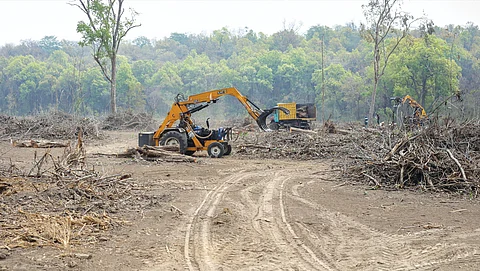

On March 17, Channa Devi of Teda village in Uttarakhand woke up to a distressing sight—her wheat crop, ready for harvest, had been trampled by a herd of elephants. “I had planted the crop on my entire 1.2-hectare (ha) field. Almost a quarter of the crop has now been damaged,” Devi tells Down To Earth (DTE), estimating the loss at 500 kg of wheat, along with the earning that would have sustained her family for at least six months. The herd of elephants must have wandered off from the nearby Jim Corbett National Park, says the 50-year-old, adding that raids by wild animals have become frequent in recent years.
In all the five villages that DTE visited in April, farmers narrate similar tales. These villages are located on the fringes of the Jim Corbett National Park and the adjoining Ramnagar forest division. Most of the farmers here have small landholdings and practice subsistence agriculture. They report crop raiding by wild herbivores, from chital (spotted deer) to sambar deer to nilgai to elephants, resulting in significant economic losses.
To curb the growing conflicts between wildlife and the farming communities, Ramnagar forest division has adopted a new approach. Since 2023, it has been replacing its monoculture plantations of teak and eucalyptus on the forest fringes, with multi-species forest plantations such as fruit trees.
Between 1973 and 1993, when present-day Uttarakhand was part of Uttar Pradesh, the forest department had planted large areas of teak and eucalyptus for commercial purposes. These species were valued for wood pulp and timber production and were harvested on a rotational basis, with around 400 ha felled annually.
According to the “India State of Forest Report 2023”, Uttarakhand has 3.8 million ha of recorded forest area. Almost 0.92 per cent of this is under teak plantations, 0.76 per cent under eucalyptus and another 0.3 per cent under a combination of these species. Although the species had commercial value, the plantations contributed little to ecological diversity and, in some cases, even harmed native ecosystems.
Sachin Pernacca Sashidhar, policy analyst at the Bengaluru-based non-profit Ashoka Trust for Research in Ecology and the Environment (ATREE), explains, “The primary eucalyptus species in India are known to deplete groundwater in dry regions, although water usage depends on the species, climate and management practices. Such plantations also have allelopathic properties. They release biochemicals that inhibit the growth and survival of other plants, thereby contributing to long-term soil degradation and reducing biodiversity in the region.”
“In recent years, we see a shift from monoculture plantations to mixed-species forests across the country,” says Ajay Maheshwari, statistical officer with the working plan division of the Ramnagar forest division. While no official notification has been released banning monoculture plantations, recent working plans for certain forest ranges and divisions have recommended the transition, based on consultations with senior officials with the Union government, Maheshwari adds.
The mixed-species plantations aim to provide better habitat and food sources for wildlife, thereby discouraging animals from straying into agricultural fields. Since 2023, 80 ha of eucalyptus and teak plantations in the western range of Ramnagar forest division have been replaced with mixed forest species, with another 160 ha slated for conversion by 2025. Fruit-bearing and native species like jamun (Syzygium cumini), amla (Phyll-anthus emblica), siras (Albizia lebbeck), khair (Senegalia catechu), kanju (Holoptelea integrifolia) and semal (Bombax ceiba) are being planted in line with the forest division’s working plan. “This is about creating food sources and safe habitats for animals inside the forest,” says Diganth Nayak, deputy conservator of forests, Ramnagar. “If food is available in the forest, animals may be less inclined to venture into farms,” he says, adding that a mixed-species forest would also foster a greater range of undergrowth vegetation, providing undisturbed habitat for the wildlife.
In addition, mixed-species forests offer a host of other ecological benefits. They support better soil moisture retention, prevent erosion, enable the growth of underbrush and improve conditions for forest regeneration.
Officials with Ramnagar forest division have also begun restoring elephant corridors by replacing timber plantations with grasslands. “The elephant corridor in Bechauri range of Ramnagar was once dominated by homogenous grassland species, which are ideal habitats for elephants. Timber plantations had shrunk these ecosystems, contributing to human-wildlife conflicts,” says Maheshwari. The plan now is to expand the 40 ha grassland to 100 ha, he adds.
While lauding the efforts of the forest officials, Sashidhar urges to follow a broader, ecosystem-based approach. “While replacing monoculture plantations with native trees is essential, it is equally important to restore native ecotypes in grasslands and wetlands,” he says. A balanced strategy that prioritises ecological diversity, habitat connectivity and climate resilience is key to the long-term sustainability of India’s forests.
This article was originally published in the 1-15 May, 2025 print edition of Down To Earth